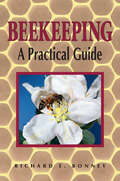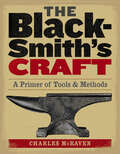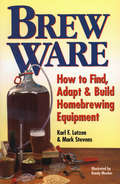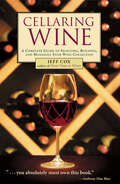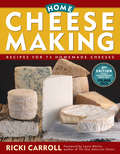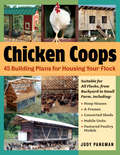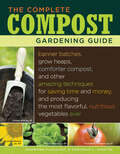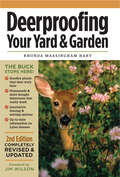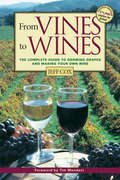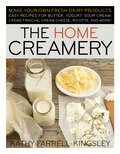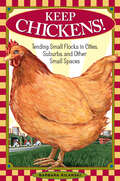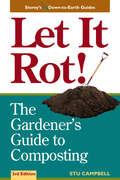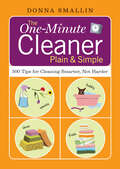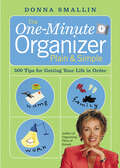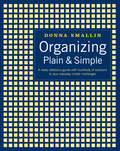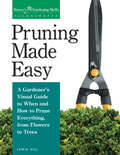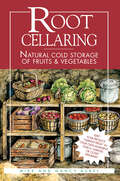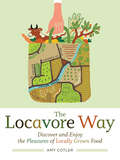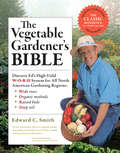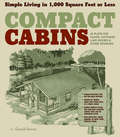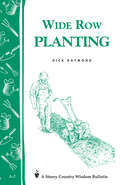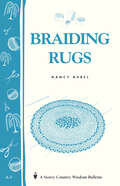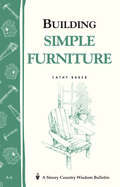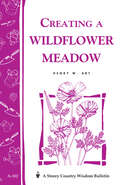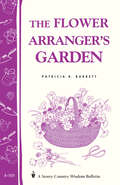- Table View
- List View
Beekeeping: A Practical Guide
by Richard E. BonneyKeep your own bees and enjoy delicious golden honey from your own backyard. With his respect and admiration for bees evident on every page, Richard E. Bonney describes how to acquire bees, manage a hive, prevent and treat diseases, and extract a crop of honey. Enthusiastic beekeepers of every stripe and experience level will benefit from Bonney’s astonishing knowledge of the craft — from beekeeping history and honeybee biology to the complex social structure of the hive.
The Blacksmith's Craft: A Primer of Tools & Methods
by Charles McRavenGet that metal hot and start hammering! Setting up your own forge and crafting everyday items is easier than you might think. With simple methods, easy-to-follow photographs, and insightful tips, you’ll soon be creating items of lasting beauty and durability from iron and steel.
Brew Ware: How to Find, Adapt & Build Homebrewing Equipment
by Mark Stevens Karl F. LutzenGear up with the right equipment and take the hassle out of homebrewing. <P><P>Karl E. Lutzen and Mark Stevens guide you through the best tools for all your brewing needs, from DIY homemade versions of commercial brewery equipment to simple devices that make brewing easier and safer. <P><P>Learn which gadgets and gizmos work best for measuring, mashing, bottling, kegging, and more. With the proper tools close at hand you’ll save both time and money, leaving you free to focus on enjoying your homebrewed beers.
Cellaring Wine: A Complete Guide to Selecting, Building, and Managing Your Wine Collection
by Jeff CoxEnjoy the rich and complex flavors of wine that’s been matured to its peak. In this comprehensive guide, Jeff Cox provides everything you need to know to build and maintain your own wine cellar. Whether you’re thinking of storing a few extra bottles in a spare closet or are looking to properly age a garage full of wine, you’ll find straightforward advice and helpful hints on successful cellaring techniques. Build and delight in your collection of wine while learning how to bring out the full potential of every bottle.
Home Cheese Making: Recipes for 75 Delicious Cheeses
by Ricki CarrollIn this home cheese making primer, Ricki Carrol presents basic techniques that will have you whipping up delicious cheeses of every variety in no time. Step-by-step instructions for farmhouse cheddar, gouda, mascarpone, and more are accompanied by inspiring profiles of home cheese makers. With additional tips on storing, serving, and enjoying your homemade cheeses, Home Cheese Making provides everything you need to know to make your favorite cheeses right in your own kitchen.
Chicken Coops: 45 Building Ideas for Housing Your Flock
by Judy PangmanJust like houses, chicken coops come in all shapes and sizes. Judy Pangman presents how-to drawings and conceptual plans for 45 coops — from the strictly practical to flights of fancy — guaranteed to meet the needs of every bird owner, however big or small your flock may be. Color photographs and innovative suggestions fill this encouraging guide, while lively anecdotes profile an array of coop builders and their various construction methods. Start building the coop of your chickens’ dreams!
The Complete Compost Gardening Guide: Banner Batches, Grow Heaps, Comforter Compost, and Other Amazing Techniques for Saving Time and Money, and Producing the Most Flavorful, Nutritious Vegetables Ever
by Barbara Pleasant Deborah L. MartinDevelop mature compost right in your garden. Barbara Pleasant and Deborah Martin explain their six-way compost gardening system in this informative guide that will have you rethinking how you create and use your compost. With your plants and compost living together from the beginning, your garden will become a nourishing and organic environment that encourages growth and sustainability. You&’ll also find that the enriched soil requires less tending, weeding, and mulching, so you can do less back-breaking work for the same lush, beautiful results. This publication conforms to the EPUB Accessibility specification at WCAG 2.0 Level AA.
Deerproofing Your Yard & Garden
by Rhonda Massingham HartFrom nibbling on fruit bushes to destroying flower beds, unwanted deer pose a frustrating and challenging obstacle to even the most patient gardeners. Rhonda Massingham Hart provides insights into deer behavior and offers a variety of proven techniques to keep your deer problem under control. Learn how to choose the best fence types, landscape with plants deer detest, make effective homemade repellents, and much more. You’ll have all the information you need to maintain a pristine, deer-free landscape.
From Vines to Wines: The Complete Guide to Growing Grapes and Making Your Own Wine
by Jeff CoxCreate you own backyard winery! From breaking ground to savoring the finished product, Jeff Cox's From Vines to Wines is the most complete and up-to-date guide to growing flawless grapes and making extraordinary wine. Wine connoisseurs, gardeners, and home winemakers will find the latest techniques in this fully revised and updated edition. With thorough, illustrated instructions, you'll learn how to: -- Choose and prepare a vineyard site -- Construct sturdy and effective trellising systems -- Plant, prune, and harvest the perfect grapes for your climate -- Press, ferment, age and bottle your own wine -- Judge wine for clarity, color, aroma, body, and taste
The Home Creamery: Make Your Own Fresh Dairy Products; Easy Recipes for Butter, Yogurt, Sour Cream, Creme Fraiche, Cream Cheese, Ricotta, and More!
by Kathy Farrell-KingsleyDiscover how easy it is to make fresh dairy products at home! You don&’t need a commercial kitchen or specialty ingredients to whip up your own cheeses, yogurts, and spreads. With simple step-by-step instructions that don&’t require complicated aging techniques, you can add a wonderful range of tart, sweet, and nutty flavors to your cooking. From fresh buttermilk for mouthwatering pancakes to creamy mozzarella in a refreshing Caprese salad, you&’ll soon enjoy the fresh flavors of your homemade dairy creations.
Keep Chickens!: Tending Small Flocks in Cities, Suburbs, and Other Small Spaces
by Barbara KilarskiNo matter how small your lot is, you can keep chickens and enjoy fresh eggs every morning. Barbara Kilarski shares her passion for poultry as she fills this guide with tips and techniques for successfully raising chickens in small spaces. Spotlighting the self-sufficient pleasures of tending your own flock, Kilarski offers detailed information on everything from choosing breeds that thrive in tight quarters and building coops to providing medical care for sick animals. You’ll have fun as you keep happy and productive chickens.
Let it Rot!: The Gardener's Guide to Composting (Third Edition) (A\down-to-earth Book Ser.)
by Stu CampbellTransform leaves, grass, and kitchen scraps into gardener’s gold! This easy-to-use guide shows you how to turn household garbage and backyard refuse into nutrient-filled compost that can nourish your soil and promote a thriving garden. You’ll soon be saving money, minimizing waste, and enjoying bountiful harvests.
The One-Minute Cleaner Plain & Simple: 500 Tips for Cleaning Smarter, Not Harder
by Donna SmallinClean smarter, not harder. Donna Smallin shows you how to quickly and effectively clear clutter, destroy dirt, and restore order. With 500 plain and simple strategies for efficiently eliminating the mess in every room, you’ll discover how easy it can be to maintain a clean home without devoting hours on end to housework. Learn how to use a spare minute here and there to shorten chores and free up more time to do the things you love.
The One-Minute Organizer Plain & Simple: 500 Tips for Getting Your Life in Order
by Donna SmallinBring order to your hectic life, quickly and efficiently. Donna Smallin offers innovative ideas and effective solutions to the busy person’s daily battle with both physical and mental clutter. This easy-to-follow guide includes 500 strategies that will help you make your world a more orderly place so that you can spend more time enjoying the things that really matter. Even if you don’t have time for a top-to-bottom organizational makeover, you can still unclutter your life . . . one short minute at a time.
Organizing Plain & Simple: A Ready Reference Guide with Hundreds of Solutions to Your Everyday Clutter Challenges
by Donna SmallinTake control of everyday disorder. With strategies for everything from keeping track of mittens and scarves to combining two households, Donna Smallin takes a personalized, nonjudgmental approach as she explains how to assess different situations and decide where to start organizing. Whether you’re craving a more functional closet, having trouble planning meals for your family, or trying to make sense of your finances, this straightforward guide offers proven techniques for living an efficient and clutter-free life. This publication conforms to the EPUB Accessibility specification at WCAG 2.0 Level AA.
Pruning Made Easy: A Gardener's Visual Guide to When and How to Prune Everything, from Flowers to Trees
by Lewis HillProper pruning will keep your landscape beautiful and thriving year after year. This authoritative guide includes more than 300 step-by-step illustrations to clearly demonstrate the correct pruning procedures for a variety of trees, shrubs, hedges, vines, and flowers. Lewis Hill offers expert advice on when, how, and why each type of plant should be pruned, safety considerations, and techniques for maintaining your pruning tools. Encouraging you to get creative, Hill even shows you how to shape your own topiaries and train espaliers.
Root Cellaring: Natural Cold Storage of Fruits & Vegetables
by Mike Bubel Nancy BubelStretch the resources of your small backyard garden further than ever before, without devoting hundreds of hours to canning! This informative and inspiring guide shows you not only how to construct your own root cellar, but how to best use the earth’s naturally cool, stable temperature as an energy-saving way to store nearly 100 varieties of perishable fruits and vegetables.
The Locavore Way: Discover And Enjoy The Pleasures Of Locally Grown Food
by Amy CotlerEating food grown close to home is not only tasty, but comes with great benefits for the health of your family, your local community, and the environment. Learn how and where to find local foods, how to eat locally on a tight budget, what questions to ask at the farmers’ market, and how to grow your own food in small spaces. With shopping tips and simple guides to preparing what’s in season, The Locavore Way makes eating locally as simple as it is delicious.
The Vegetable Gardener's Bible, 2nd Edition: Discover Ed's High-Yield W-O-R-D System for All North American Gardening Regions: Wide Rows, Organic Methods, Raised Beds, Deep Soil
by Edward C. SmithSmith’s legendary high-yield gardening method emphasizes wide rows, organic methods, raised beds, and deep soil. Succeed with fussy plants, try new and unusual varieties, and learn how to innovatively extend your growing season. With thorough profiles of hundreds of popular varieties, The Vegetable Gardener’s Bible provides expert information and an inspiring roadmap for gardeners of all skill levels to enjoy abundant homegrown vegetables.
Compact Cabins: Simple Living in 1000 Square Feet or Less; 62 Plans for Camps, Cottages, Lake Houses, and Other Getaways
by Gerald RowanIn the woods, on a mountaintop, or at the water&’s edge, a small cabin can fulfill big dreams. With attention to efficient living and minimizing energy footprints, Gerald Rowan provides 62 designs for compact and creative buildings that are flexible enough to fit whatever your needs may be. Rowan includes detailed floor plans with plenty of modular elements that make the designs adaptable and easy to recreate with cost-effective, low-maintenance materials. Make the most of the cabin you call home, regardless of its size.
Wide Row Planting: Storey's Country Wisdom Bulletin A-02
by Dick RaymondSince 1973, Storey's Country Wisdom Bulletins have offered practical, hands-on instructions designed to help readers master dozens of country living skills quickly and easily. There are now more than 170 titles in this series, and their remarkable popularity reflects the common desire of country and city dwellers alike to cultivate personal independence in everyday life.
Braiding Rugs: A Storey Country Wisdom Bulletin A-03 (Storey Country Wisdom Bulletin Ser.)
by Nancy BubelBraided rugs are like family quilts – each strip of cloth comes from a cast-off garment and tells a story all its own. Piecing the rug together is an act of weaving family memories into a useful heirloom you'll treasure forever. Nancy Bubel covers every step of the simple process, from planning the perfect size, shape, and color scheme to cutting your cloth strips, braiding them together, and finishing off your rug.
Building Simple Furniture: Storey Country Wisdom Bulletin A-06 (Storey Country Wisdom Bulletin Ser.)
by Cathy BakerEASY-TO-BUILD PROJECTS FOR THE WEEKEND WOODWORKER! <P><P>Look over the variety of simple wood-working projects in the bulletin and you’ll quickly find something that deserves a place in your home. A small table for the hallway, perhaps, or an Adirondack chair or picnic set for the deck or garden? <P><P>The good news is that you don’t need to be a master carpenter with a basement full of power tools to craft these handsome and practical items. With a few simple hand tools and Cathy Baker’s step-by-step instructions and easy-to-follow illustrations and diagrams, you can build sturdy, durable, beautiful wooden furniture that you and your family will enjoy for years to come. <P><P>Projects include:· <br> Wall shelf· <br> Small bench· <br> Picnic table and benches· <br> Adirondack chair· <br> Pump lamp· <br> Step stool· <br> Storage box· <br> Side table
Creating a Wildflower Meadow: Storey's Country Wisdom Bulletin A-102
by Henry W. ArtSince 1973, Storey's Country Wisdom Bulletins have offered practical, hands-on instructions designed to help readers master dozens of country living skills quickly and easily. There are now more than 170 titles in this series, and their remarkable popularity reflects the common desire of country and city dwellers alike to cultivate personal independence in everyday life.
The Flower Arranger's Garden: A Storey's Country Wisdom Bulletin (Storey Country Wisdom Bulletin Ser.)
by Patricia R. BarrettSince 1973, Storey's Country Wisdom Bulletins have offered practical, hands-on instructions designed to help readers master dozens of country living skills quickly and easily. There are now more than 170 titles in this series, and their remarkable popularity reflects the common desire of country and city dwellers alike to cultivate personal independence in everyday life.
